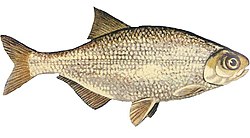| Lycoptera Temporal range: | |
|---|---|
 | |
| L. davidi, from Yixian, Liaoning, China, Lower Cretaceous (Aptian) | |
| Scientific classification | |
| Kingdom: | Animalia |
| Phylum: | Chordata |
| Class: | Actinopterygii |
| Cohort: | Osteoglossomorpha |
| Order: | † Lycopteriformes |
| Family: | † Lycopteridae |
| Genus: | † Lycoptera Müller, 1847 |
| Type species | |
| †Lycoptera middendorffi Müller, 1847 | |
| Species | |
| Synonyms | |
| |
Lycoptera is an extinct genus of fish that lived from Lower Cretaceous, Barremian to Aptian [1] in present-day China, North Korea, [2] Mongolia and Siberia. Although there is record from Jurassic Formation in Siberia, its age remains questionable. [3] It is known from abundant fossils representing sixteen species, which serve as important index fossil used to date geologic formations in China. Along with the genus Peipiaosteus , Lycoptera has been considered a defining member of the Jehol Biota, a prehistoric ecosystem famous for its feathered dinosaurs, which flourished for 20 million years during the Early Cretaceous, where it occurs abundantly in often monospecific beds, where they are thought to have died in seasonal mass death events. [4] [5] Lycoptera is a crown group teleost belonging to an early diverging lineage of the Osteoglossomorpha, which contains living mooneyes, arapaima, arowana, elephantfish and knifefish/featherbacks. [6]




